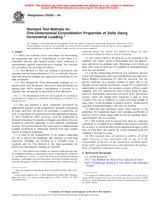Potrebujeme váš súhlas na využitie jednotlivých dát, aby sa vám okrem iného mohli ukazovať informácie týkajúce sa vašich záujmov. Súhlas udelíte kliknutím na tlačidlo „OK“.
ASTM D2435-04
Standard Test Methods for One-Dimensional Consolidation Properties of Soils Using Incremental Loading
Automaticky preložený názov:
Štandardné testovacie metódy pre jednorozmerných Konsolidačné vlastnosti zemín použitie prírastkové Loading
NORMA vydaná dňa 1.11.2004
Informácie o norme:
Označenie normy: ASTM D2435-04
Poznámka: NEPLATNÁ
Dátum vydania normy: 1.11.2004
Kód tovaru: NS-20363
Počet strán: 10
Približná hmotnosť: 30 g (0.07 libier)
Krajina: Americká technická norma
Kategória: Technické normy ASTM
Anotácia textu normy ASTM D2435-04 :
Keywords:
compressibility, compression curves, consolidation, consolidation coefficient, consolidation test, consolidometer, preconsolidation pressure, primary consolidation, rebound, secondary compression, settlement, swelling, ICS Number Code 93.020 (Earth works. Excavations. Foundation construction. Underground works)
Doplňujúce informácie
| 1. Scope | ||||||||||||||||||||||||||||||||||
|
1.1 This test method covers procedures for determining the magnitude and rate of consolidation of soil when it is restrained laterally and drained axially while subjected to incrementally applied controlled-stress loading. Two alternative procedures are provided as follows: 1.1.1 Test Method A—This test method is performed with constant load increment duration of 24 h, or multiples thereof. Time-deformation readings are required on a minimum of two load increments. 1.1.2 Test Method B—Time-deformation readings are required on all load increments. Successive load increments are applied after 100 % primary consolidation is reached, or at constant time increments as described in Test Method A. Note 1—The determination of the rate and magnitude of consolidation of soil when it is subjected to controlled-strain loading is covered by Test Method D 4186. 1.2 This test method is most commonly performed on undisturbed samples of fine grained soils naturally sedimented in water, however, the basic test procedure is applicable, as well, to specimens of compacted soils and undisturbed samples of soils formed by other processes such as weathering or chemical alteration. Evaluation techniques specified in this test method are generally applicable to soils naturally sedimented in water. Tests performed on other soils such as compacted and residual (weathered or chemically altered) soils may require special evaluation techniques. 1.3 It shall be the responsibility of the agency requesting this test to specify the magnitude and sequence of each load increment, including the location of a rebound cycle, if required, and, for Test Method A, the load increments for which time-deformation readings are desired. Note 2—Time-deformation readings are required to determine the time for completion of primary consolidation and for evaluating the coefficient of consolidation. Since c varies with stress level and load increment (loading or unloading), the load increments with timed readings must be selected with specific reference to the individual project. Alternatively, the requesting agency may specify Test Method B wherein the time-deformation readings are taken on all load increments. 1.4 The values stated in SI units are to be regarded as the standard. The values stated in inch-pound units are approximate and given for guidance only. Reporting of test results in units other than SI shall not be regarded as nonconformance with this test method. 1.4.1 In the engineering profession it is customary practice to use, interchangeably, units representing both mass and force, unless dynamic calculation (F = Ma) are involved. This implicitly combines two separate systems of units, that is, the absolute system and the gravimetric system. It is scientifically undesirable to combine two separate systems within a single standard. This test method has been written using SI units; however, inch-pound conversions are given in the gravimetric system, where the pound (lbf) represents a unit of force (weight). The use of balances or scales recording pounds of mass (lbm), or the recording of density in lb/ft should not be regarded as nonconformance with this test method. 1.5 All observed and calculated values shall conform to the guidelines for significant digits and rounding established in Practice D 6026. 1.5.1 The method used to specify how data are collected, calculated, or recorded in this standard is not directly related to the accuracy to which the data can be applied in design or other uses, or both. How one applies the results obtained using this standard is beyond its scope. 1.6 This standard does not purport to address all of the safety concerns, it any, associated with its use. It is the responsibility of the user of this standard to establish appropriate safety and health practices and determine the applicability of regulatory limitations prior to use. |
||||||||||||||||||||||||||||||||||
| 2. Referenced Documents | ||||||||||||||||||||||||||||||||||
|
Odporúčame:
EviZak - všetky zákony vrátane ich evidencie na jednom mieste
Poskytovanie aktuálnych informácií o legislatívnych predpisoch vyhlásených v Zbierke zákonov od roku 1945.
Aktualizácia 2x v mesiaci !
Chcete vedieť viac informácii ? Pozrite sa na túto stránku.




 Cookies
Cookies
